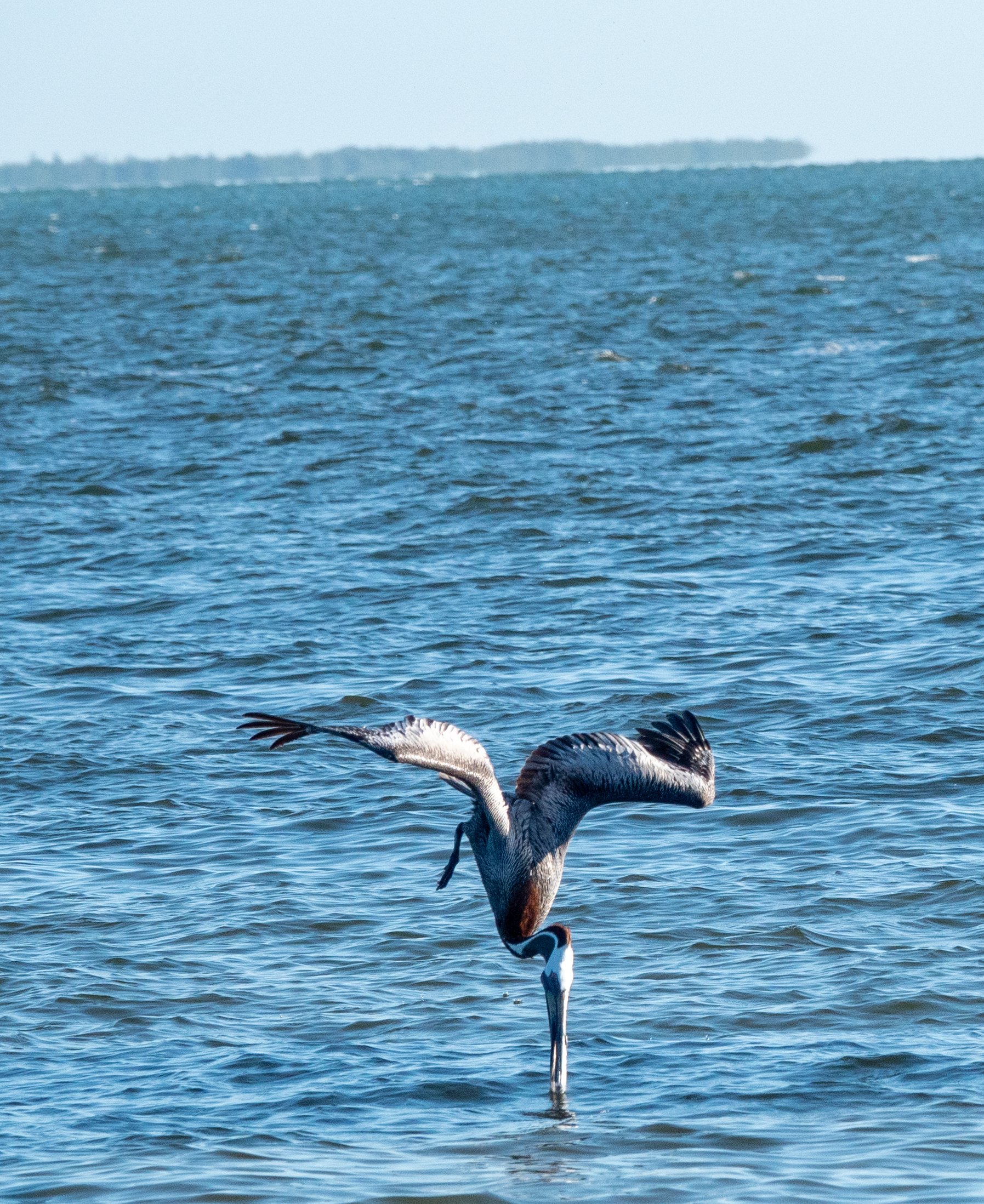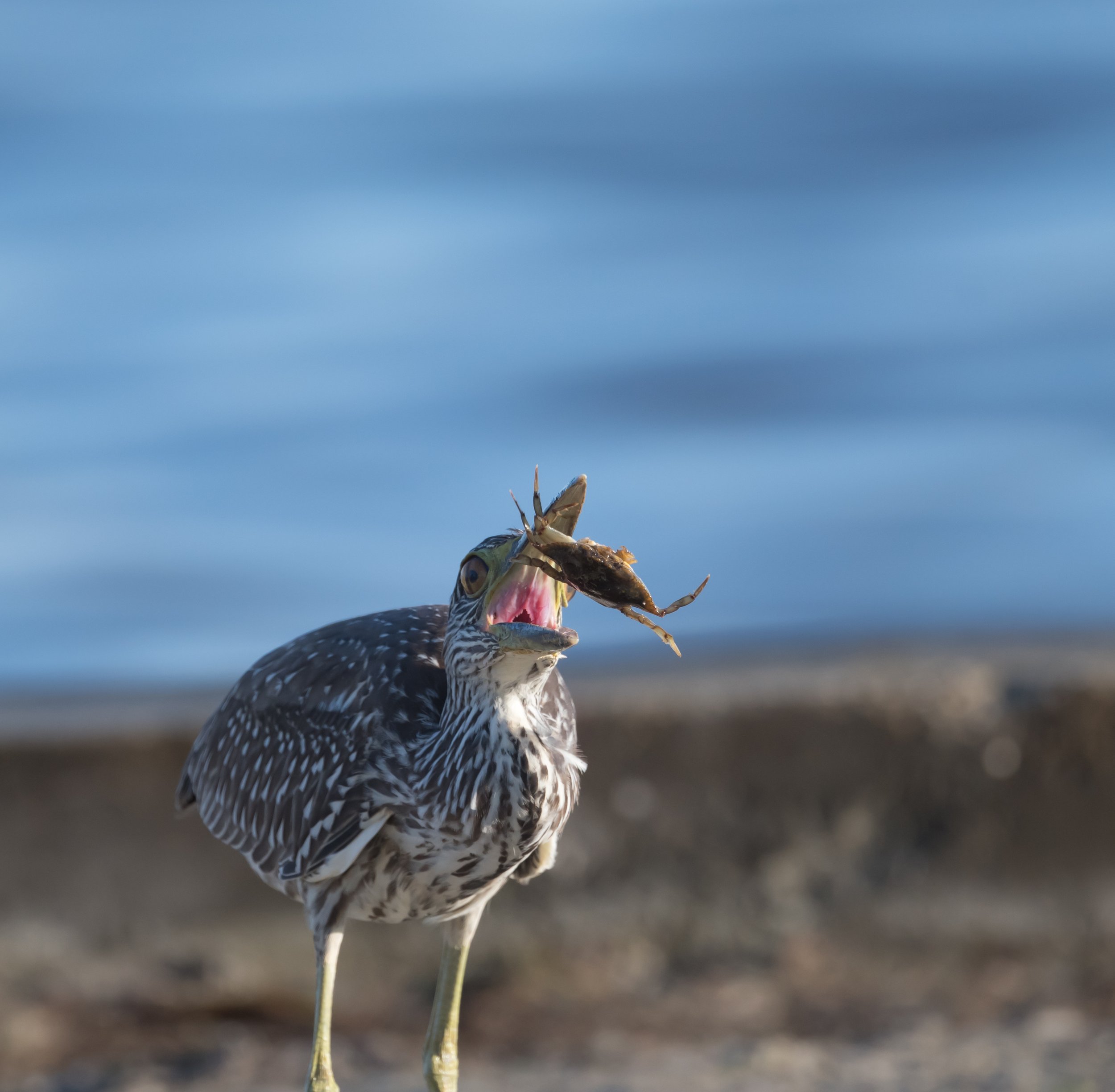 Image 1 of
Image 1 of


8x10 photo of a pelican diving for fish
Pelicans are fascinating birds known for their distinctive long beaks and large throat pouches, which they use to catch fish. When diving for fish, pelicans employ a unique hunting technique that showcases their impressive adaptations.
Diving Technique:
Observation: Pelicans often fly low over the water, scanning for schools of fish. They can spot potential catches from a height, thanks to their keen eyesight.
Preparation: Once they identify a target area, they may circle above it to get a better view and position themselves accurately.
Diving: Pelicans can perform a dramatic dive into the water. They typically plunge into the water from heights of up to 10-15 feet. They fold their wings back against their bodies to reduce resistance during the dive.
Capturing Fish: Upon hitting the water, the pelican's throat pouch acts as a net. As they submerge, they open their beak wide, allowing water to rush in while trapping the fish inside the pouch.
Swimming to Surface: After capturing fish, pelicans use their wings to propel themselves back to the surface, filtering the water from their pouch while keeping the fish.
Consumption: Once back on the surface, pelicans drain the excess water from their pouches and tilt their heads back to swallow the fish.
Social Behavior:
Pelicans often hunt in groups, working together to herd fish into shallower waters, making it easier for the entire group to catch food. This social hunting behavior increases their efficiency and improves their chances of a successful catch.
Adaptations:
Beak and Pouch: Their long, hooked beaks and expandable pouches are key adaptations for fishing. The pouch can hold several gallons of water, allowing for effective capture of prey.
Size and Weight: Pelicans are large, with some species weighing up to 30 pounds. Their size helps them dive effectively and store larger fish.
Species:
There are several species of pelicans, including the American White Pelican, Brown Pelican, and Australian Pelican, each with slightly different diving behaviors and adaptations based on their habitats.
Overall, the diving techniques of pelicans are a remarkable example of evolutionary adaptation, allowing them to be highly effective hunters in aquatic environments.
Pelicans are fascinating birds known for their distinctive long beaks and large throat pouches, which they use to catch fish. When diving for fish, pelicans employ a unique hunting technique that showcases their impressive adaptations.
Diving Technique:
Observation: Pelicans often fly low over the water, scanning for schools of fish. They can spot potential catches from a height, thanks to their keen eyesight.
Preparation: Once they identify a target area, they may circle above it to get a better view and position themselves accurately.
Diving: Pelicans can perform a dramatic dive into the water. They typically plunge into the water from heights of up to 10-15 feet. They fold their wings back against their bodies to reduce resistance during the dive.
Capturing Fish: Upon hitting the water, the pelican's throat pouch acts as a net. As they submerge, they open their beak wide, allowing water to rush in while trapping the fish inside the pouch.
Swimming to Surface: After capturing fish, pelicans use their wings to propel themselves back to the surface, filtering the water from their pouch while keeping the fish.
Consumption: Once back on the surface, pelicans drain the excess water from their pouches and tilt their heads back to swallow the fish.
Social Behavior:
Pelicans often hunt in groups, working together to herd fish into shallower waters, making it easier for the entire group to catch food. This social hunting behavior increases their efficiency and improves their chances of a successful catch.
Adaptations:
Beak and Pouch: Their long, hooked beaks and expandable pouches are key adaptations for fishing. The pouch can hold several gallons of water, allowing for effective capture of prey.
Size and Weight: Pelicans are large, with some species weighing up to 30 pounds. Their size helps them dive effectively and store larger fish.
Species:
There are several species of pelicans, including the American White Pelican, Brown Pelican, and Australian Pelican, each with slightly different diving behaviors and adaptations based on their habitats.
Overall, the diving techniques of pelicans are a remarkable example of evolutionary adaptation, allowing them to be highly effective hunters in aquatic environments.
Pelicans are fascinating birds known for their distinctive long beaks and large throat pouches, which they use to catch fish. When diving for fish, pelicans employ a unique hunting technique that showcases their impressive adaptations.
Diving Technique:
Observation: Pelicans often fly low over the water, scanning for schools of fish. They can spot potential catches from a height, thanks to their keen eyesight.
Preparation: Once they identify a target area, they may circle above it to get a better view and position themselves accurately.
Diving: Pelicans can perform a dramatic dive into the water. They typically plunge into the water from heights of up to 10-15 feet. They fold their wings back against their bodies to reduce resistance during the dive.
Capturing Fish: Upon hitting the water, the pelican's throat pouch acts as a net. As they submerge, they open their beak wide, allowing water to rush in while trapping the fish inside the pouch.
Swimming to Surface: After capturing fish, pelicans use their wings to propel themselves back to the surface, filtering the water from their pouch while keeping the fish.
Consumption: Once back on the surface, pelicans drain the excess water from their pouches and tilt their heads back to swallow the fish.
Social Behavior:
Pelicans often hunt in groups, working together to herd fish into shallower waters, making it easier for the entire group to catch food. This social hunting behavior increases their efficiency and improves their chances of a successful catch.
Adaptations:
Beak and Pouch: Their long, hooked beaks and expandable pouches are key adaptations for fishing. The pouch can hold several gallons of water, allowing for effective capture of prey.
Size and Weight: Pelicans are large, with some species weighing up to 30 pounds. Their size helps them dive effectively and store larger fish.
Species:
There are several species of pelicans, including the American White Pelican, Brown Pelican, and Australian Pelican, each with slightly different diving behaviors and adaptations based on their habitats.
Overall, the diving techniques of pelicans are a remarkable example of evolutionary adaptation, allowing them to be highly effective hunters in aquatic environments.














